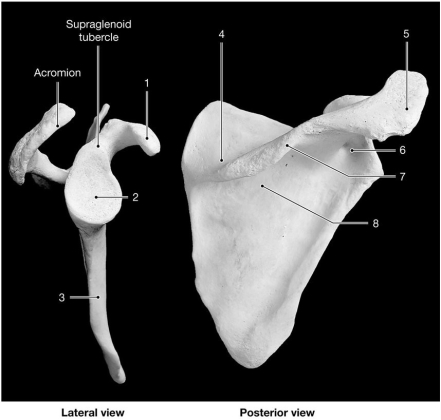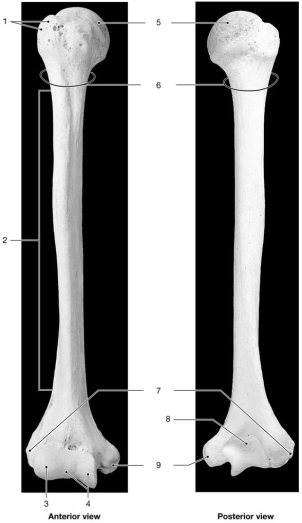A) patella.
B) pelvis.
C) pectoral girdle.
D) coccyx.
E) coxal bone.
Correct Answer

verified
Correct Answer
verified
Multiple Choice
The bones of the forearm,or ________,consist of the radius and ulna.
A) olecranon region
B) brachium
C) antecubital region
D) antebrachium
E) cubital region
Correct Answer

verified
Correct Answer
verified
Multiple Choice
The bones that give the hand a wide range of motion are the
A) carpals.
B) tarsals.
C) metacarpals.
D) metatarsals.
E) phalanges.
Correct Answer

verified
Correct Answer
verified
Multiple Choice
The ________ of the radius helps stabilize the wrist joint.
A) olecranon process
B) coronoid process
C) styloid process
D) radial tuberosity
E) capitulum
Correct Answer

verified
Correct Answer
verified
Essay
To settle a bet,you need to measure the length of your lower limb (head of femur to distal end of tibia).What landmarks would you use to make the measurement?
Correct Answer

verified
You could feel the lesser scia...View Answer
Show Answer
Correct Answer
verified
View Answer
Multiple Choice
The two pubic bones join medially at the
A) pubic tuberosity.
B) superior ramus.
C) inferior ramus.
D) pubic tubercle.
E) pubic symphysis.
Correct Answer

verified
Correct Answer
verified
Multiple Choice
The scapula is roughly triangular in shape.Which of the following are correct terms for the borders?
A) superior,medial,and lateral borders
B) dorsal and costal borders
C) anterior and posterior borders
D) scapular and clavicular borders
E) pectoral borders
Correct Answer

verified
Correct Answer
verified
Multiple Choice
When seated,the weight of the body is borne by the
A) ischial tuberosities.
B) posterior inferior iliac spines.
C) iliac crests.
D) obturator foramina.
E) inferior rami of the pubis.
Correct Answer

verified
Correct Answer
verified
Multiple Choice
Identify the incorrect descriptor of congenital talipes equinovarus (club foot) .
A) due to inappropriately developed arches
B) may involve one or both feet
C) may affect the tibia,ankle,and foot
D) feet are turned laterally and everted
E) may be treated with casts or supports in infancy
Correct Answer

verified
Correct Answer
verified
Multiple Choice
Which of the following is not a characteristic of the male pelvis?
A) heavy,rough textured bone
B) heart-shaped pelvic inlet
C) angle of pubic arch greater than 100 degrees
D) relatively deep iliac fossa
E) ilia extend far above sacrum
Correct Answer

verified
Correct Answer
verified
Multiple Choice
The pelvic organs are mostly found within the
A) ischial spine.
B) iliac fossa.
C) ischial fossa.
D) obturator foramen.
E) pubic symphysis.
Correct Answer

verified
Correct Answer
verified
Multiple Choice
The space enclosed by the true pelvis is called the
A) pelvic inlet.
B) false pelvis.
C) pelvic brim.
D) pelvic outlet.
E) lesser pelvis.
Correct Answer

verified
Correct Answer
verified
Multiple Choice
The lateral malleolus is found on the
A) femur.
B) tibia.
C) fibula.
D) patella.
E) calcaneus.
Correct Answer

verified
Correct Answer
verified
Multiple Choice
 Figure 8-1 The Scapula
Use Figure 8-1 to answer the following questions:
-Identify the structure labeled "7."
Figure 8-1 The Scapula
Use Figure 8-1 to answer the following questions:
-Identify the structure labeled "7."
A) acromion
B) scapular process
C) spine of scapula
D) coracoid process
E) scapular notch
Correct Answer

verified
Correct Answer
verified
Multiple Choice
The clavicle articulates with the scapula
A) laterally with the coracoid process.
B) laterally with the glenoid cavity.
C) laterally with the acromion.
D) laterally with the manubrium.
E) medially with the coracoid cavity.
Correct Answer

verified
Correct Answer
verified
Multiple Choice
A ligament attaches the acetabulum to the femur at the ________,a small pit in the center of the femoral head.
A) greater trochanter
B) lesser trochanter
C) fovea capitis
D) gluteal tuberosity
E) lateral lip
Correct Answer

verified
Correct Answer
verified
Multiple Choice
Which of the following is not a part of the pelvis?
A) sacrum
B) coccyx
C) coxal bone
D) lumbar vertebrae
E) pubic symphysis
Correct Answer

verified
Correct Answer
verified
Multiple Choice
 Figure 8-1 The Scapula
Use Figure 8-1 to answer the following questions:
-Identify the structure labeled " 1."
Figure 8-1 The Scapula
Use Figure 8-1 to answer the following questions:
-Identify the structure labeled " 1."
A) spine of scapula
B) scapular process
C) acromion
D) coracoid process
E) scapular notch
Correct Answer

verified
Correct Answer
verified
Multiple Choice
 Figure 8-2 The Humerus
Use Figure 8-2 to answer the following questions:
-Identify the place where the humerus often fractures.
Figure 8-2 The Humerus
Use Figure 8-2 to answer the following questions:
-Identify the place where the humerus often fractures.
A) 1
B) 2
C) 5
D) 6
E) 7
Correct Answer

verified
Correct Answer
verified
Multiple Choice
A male has a ________ pelvic outlet when compared to the woman's pelvic outlet.
A) larger
B) longer
C) smaller
D) wider
E) deeper
Correct Answer

verified
Correct Answer
verified
Showing 81 - 100 of 115
Related Exams